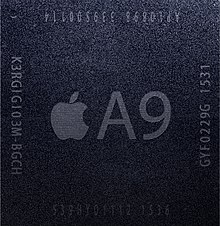 Apple A9 processor | |
| General information | |
|---|---|
| Launched | September 9, 2015 |
| Discontinued | September 12, 2018 |
| Designed by | Apple Inc. |
| Common manufacturer | |
| Product code | APL0898,[1] APL1022[2] |
| Performance | |
| Max. CPU clock rate | 1.85 GHz (iPhone 6s, iPhone 6s Plus, iPhone SE, iPad 9.7 2017)[3][4] |
| Cache | |
| L1 cache | Per core: 64 KB instruction + 64 KB data |
| L2 cache | 3 MB shared[5] |
| L3 cache | 4 MB shared[6] |
| Architecture and classification | |
| Application | Mobile |
| Technology node | 14 nm (Samsung 14LPE), 16 nm (TSMC 16FFC) |
| Microarchitecture | Twister[7][8] |
| Instruction set | ARMv8-A: A64, A32, T32 |
| Physical specifications | |
| Cores |
|
| GPU | Custom PowerVR Series 7XT (six-core) @ 650MHz [9][10][11] |
| Products, models, variants | |
| Variant | |
| History | |
| Predecessors | Apple A8 (iPhone) Apple A8X (iPad) |
| Successors | Apple A10 Fusion (iPhone) Apple A10X Fusion (iPad) |
The Apple A9 is a 64-bit ARM-based system-on-chip (SoC)designed by Apple Inc., part of the Apple silicon series. Manufactured for Apple by both TSMC and Samsung, it first appeared in the iPhone 6s and 6s Plus which were introduced on September 9, 2015.[12] Apple states that it has 70% more CPU performance and 90% more graphics performance compared to its predecessor, the Apple A8.[12] On September 12, 2018, the iPhone 6s and iPhone 6s Plus along with the first-generation iPhone SE was discontinued, ending production of A9 chips. The latest software updates for the iPhone 6s & 6s Plus including the iPhone SE (1st generation) variants systems using this chip are iOS 15.8.3, released around August, 2024, as they were discontinued with the release of iOS 16 in 2022, and for the iPad (5th generation) using this chip was iPadOS 16.7.10, also released on September 3, 2024, as it was discontinued with the release of iPadOS 17 in 2023.
- ^ "iPhone 6s Teardown". iFixit. September 25, 2015. Archived from the original on January 10, 2016. Retrieved September 26, 2015.
- ^ "A9 is TSMC 16nm FinFET and Samsung Fabbed". Archived from the original on 2016-09-17. Retrieved 2015-09-28.
- ^ "iPhone 6s customer receives her device early, benchmarks show a marked increase in power". iDownloadBlog. September 21, 2015. Archived from the original on September 24, 2015. Retrieved September 25, 2015.
- ^ "Revealed: iPhone 6S uses 1.85GHz dual-core A9 chip". Trusted Reviews. September 18, 2015. Archived from the original on January 5, 2016. Retrieved September 25, 2015.
- ^ a b "Inside the iPhone 6s". Chipworks. September 25, 2015. Archived from the original on February 3, 2017. Retrieved September 26, 2015.
- ^ Cite error: The named reference
AnandTech A9 L3 Cache Sizewas invoked but never defined (see the help page). - ^ Joshua Ho. "iPhone 6s and iPhone 6s Plus Preliminary Results". Archived from the original on 2016-05-26. Retrieved 2016-09-25.
- ^ Joshua Ho, Ryan Smith. "A9's CPU: Twister - The Apple iPhone 6s and iPhone 6s Plus Review". Archived from the original on 2016-01-18. Retrieved 2016-09-25.
- ^ "iPhone 6S Review". GSM Arena. October 2015. Archived from the original on 2016-01-12. Retrieved 2016-09-25.
- ^ "Apple A9 / PowerVR GT7600". NotebookCheck. September 2015. Archived from the original on 2016-01-21. Retrieved 2016-09-25.
- ^ Kanter, David. "A Look Inside Apple's Custom GPU for the iPhone". Archived from the original on 2019-08-27. Retrieved 2019-08-27.
- ^ a b "Apple Introduces iPhone 6s & iPhone 6s Plus" (Press release). Apple. September 9, 2015. Archived from the original on September 11, 2015. Retrieved September 9, 2015.